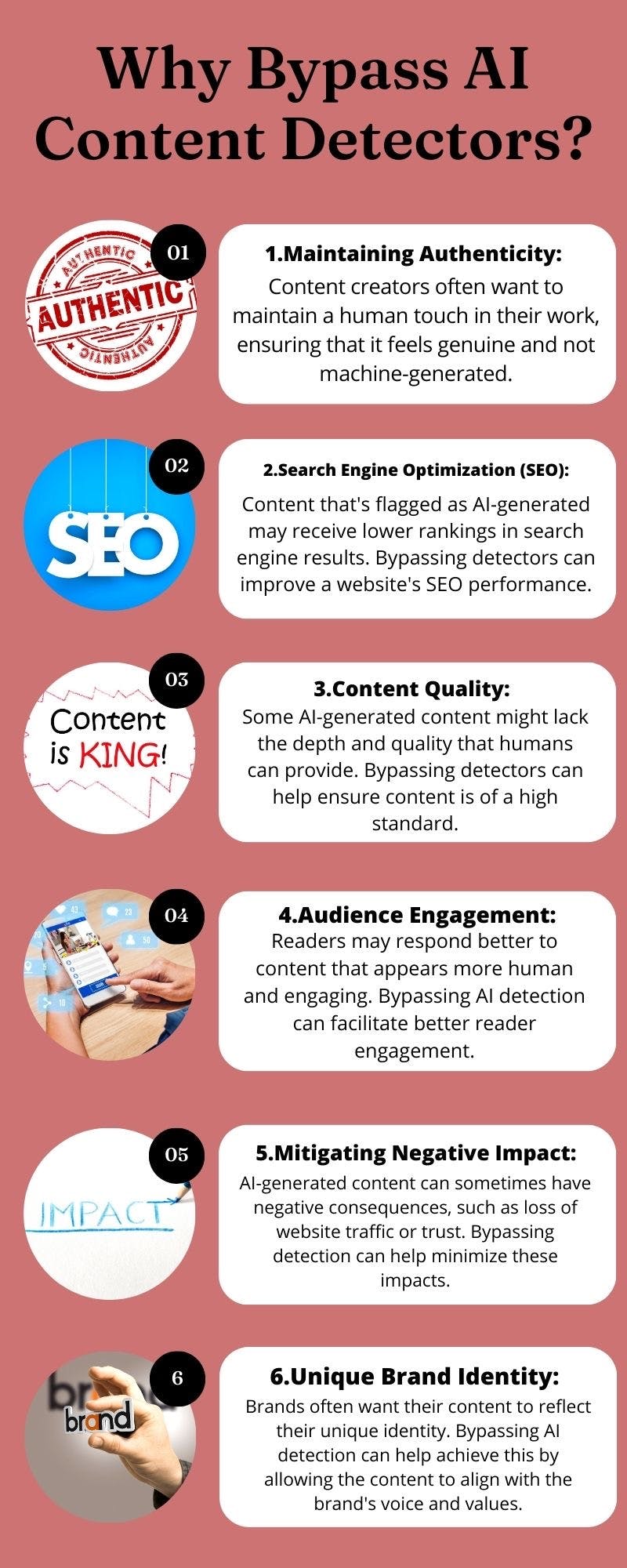How To Bypass AI Content Detectors - 11 Practical Tips

In today's digital world, where artificial intelligence tools play an important role in content generation, understanding how to navigate and even bypass AI content detectors has become crucial.
As AI algorithms become more sophisticated, knowing how to work around them is essential to ensure your content reaches your intended audience without getting caught by the AI content detectors.
So, whether you are a blogger, a content creator, or someone who simply wants to explore the boundaries of AI content detection, this article will provide you with 11 practical tips to help you bypass AI content detectors.
Let's get started.
Why Bypass AI Content Detectors?

Before getting straight to the tips of bypassing AI content detectors, it's essential to understand why you should bypass AI content detectors.
Well, bypassing AI content detectors is not necessary, but it's a piece of mind.
Besides that, there are some important reasons why you should bypass AI content detectors.
The reasons are:
Maintaining Authenticity: Content creators often want to maintain a human touch in their work, ensuring that it feels genuine and not machine-generated.
Search Engine Optimization (SEO): Content that's flagged as AI-generated may receive lower rankings in search engine results. Bypassing detectors can improve a website's SEO performance.
Content Quality: Some AI-generated content might lack the depth and quality that humans can provide. Bypassing detectors can help ensure content is of a high standard.
Audience Engagement: Readers may respond better to content that appears more human and engaging. Bypassing AI detection can facilitate better reader engagement.
Mitigating Negative Impact: AI-generated content can sometimes have negative consequences, such as loss of website traffic or trust. Bypassing detection can help minimize these impacts.
Unique Brand Identity: Brands often want their content to reflect their unique identity. Bypassing AI detection can help achieve this by allowing the content to align with the brand's voice and values.
So these reasons clearly show bypassing AI content detectors may not always be necessary, but it can offer peace of mind and serve specific purposes.
Now, let's learn how AI content detectors work.
How Do AI Content Detectors Work?

In order to bypass AI content detectors, it's important to understand how AI content detector tools work.
Well, the majority of AI content detectors look for some common patterns or indicators that suggest AI involvement.
These patterns include:
Pattern Recognition: AI content detectors are trained to recognize patterns and structures commonly associated with AI-generated content. This includes the use of repetitive phrases, sentence structures, and grammatical inconsistencies.
Comparative Analysis: These detectors often compare the text they analyze with existing databases of known AI-generated content. If the content closely matches what's in the database, it's more likely to be flagged as AI-generated.
Natural Language Processing (NLP): Many AI content detectors utilize natural language processing (NLP) techniques to examine the text for patterns that resemble human language. NLP helps identify nuanced differences between human and AI-generated content.
Signs of Automation: AI detectors also look for signs of content creation automation, such as a lack of originality, predictable content flow, and an overly formal tone.
Contextual Analysis: Some detectors consider the context of the content, including the subject matter and the intended audience, to determine whether the content aligns with human expectations.
So, this is how the majority of AI content detectors work. In order to bypass these tools, you will have to take deliberate steps to create content that doesn't trigger their detection algorithms.
Let's learn this below.
11 Practical Tips to Bypass AI Content Detectors
So, here are the 11 practical tips to bypass AI content detectors and make the most out of your AI-generated content.
1. Use An AI Content Bypass Tool

One effective way to bypass AI content detectors is to utilize AI content bypass tools specifically designed for this purpose. These tools can automatically tweak your content to make it appear more human-generated. They work by introducing subtle variations in the text, such as changing word choices, rephrasing sentences, and altering sentence structures.
These alterations can confuse the detectors and make it harder for them to flag your content as AI-generated. While using these tools, it's important to review the output carefully to ensure that the changes maintain the original intent and meaning of your content.
Here are some famous AI content bypass tools that you can consider using:
WriteHuman
Smodin
GPTinf
Parapharasingtool.ai
Undetectable.ai
AISEO - Bypass AI Detection
HideMyAi
By employing an AI content bypass tool, you can streamline the process and make it less time-consuming, especially if you're dealing with large volumes of content. It's a handy solution for content creators who want to maintain authenticity while still benefiting from the efficiency of AI content generation.
2. Use Unique Writing Styles
One of the key indicators that AI content detectors look for is uniformity in writing style. To bypass these detectors, it's essential to develop a unique and distinctive writing style that sets your content apart from typical AI-generated text.
Focus on developing a voice and tone that align with your brand or personal identity. Inject personality, humor, or a specific tone that resonates with your audience. By creating a consistent and distinctive style, you make it more challenging for AI detectors to classify your content as machine-generated.
Consistently using this unique style across your content can help establish authenticity and ensure that your audience connects with your material on a more human level.
3. Include Different Sources

AI content detectors often associate machine-generated content with a lack of variety in sources and perspectives. To counter this, incorporate a diverse range of sources, quotes, and references in your content. This demonstrates that your work is well-researched and incorporates multiple viewpoints.
When writing an article about climate change, include quotes and statistics from a variety of experts, researchers, and organizations. Reference scientific studies, government reports, and interviews with climate scientists.
For example, quote both "Dr. Smith, a climate scientist" and "The World Meteorological Organization." Reference "a recent NASA report" and "research from the University of California."
When you quote experts, include opinions from various individuals, and cite diverse sources, it adds depth and credibility to your content. This diversification can make it less likely for AI detectors to categorize your work as AI-generated and more likely to be perceived as authentic and well-informed.
In addition to improving your content's authenticity, this approach can also enhance its quality and relevance.
4. Include Personal Anecdotes
Human experiences and anecdotes can add a personal touch to your content, making it more engaging and relatable. Share personal stories or experiences that connect with the subject matter to give your content a human touch.
If you're writing a travel blog about a recent trip to Italy, share personal experiences. Instead of just listing tourist attractions, include anecdotes like, "While exploring the charming streets of Florence, I stumbled upon a local gelato shop. The taste of freshly made gelato, combined with the beauty of the city, created an unforgettable memory."
By weaving in anecdotes and narratives, you can create a sense of authenticity and relatability that is challenging for AI detectors to mimic. It adds a layer of emotional depth to your content, making it resonate more strongly with your readers. This emotional connection can help engage your audience and keep them invested in your content.
Including personal anecdotes also underscores the idea that a human, not a machine, is behind the content's creation.
5. Write in a Simple Tone and Style
Complex sentence structures, advanced vocabulary, and overly formal language are often telltale signs of AI-generated content. To bypass AI content detectors, aim for simplicity in your writing. Use clear, concise sentences and everyday language that your audience can easily understand.
A straightforward, conversational tone can make your content appear more human. Avoid jargon or overly technical terms that might trigger the detectors. Instead, focus on conveying your message in a manner that is approachable and relatable.
Additionally, simplicity in writing style can improve the overall readability and accessibility of your content, making it more appealing to a wider audience.
6. Incorporate Jargon and Acronyms
While simplicity is essential, judiciously incorporating industry-specific jargon and acronyms relevant to your content can actually enhance its authenticity. When used appropriately, these specialized terms signal your expertise and insider knowledge, making your content appear more genuine.
For example, In an article about AI, you can use terms like "NLP" (Natural Language Processing), "ML" (Machine Learning), or "DL" (Deep Learning) appropriately to demonstrate your expertise.
However, use this tip with caution. Overusing jargon or acronyms can backfire, making your content seem forced and artificial. Striking the right balance between plain language and industry-specific terminology is key.
By demonstrating your grasp of the subject matter through well-placed jargon, you can create content that seems human, knowledgeable, and authoritative.
7. Use Active Voice Sentences
AI content detectors often flag passive voice sentences as a sign of automated content generation. To bypass these detectors, favor active voice sentences in your writing. Active voice emphasizes the doer of the action and typically results in clearer, more direct sentences.
For example, instead of saying, "The report was written by the team," you can use the active voice: "The team wrote the report." This not only makes your content more readable but also less likely to be labeled as AI-generated.
Using active voice sentences enhances the human-like quality of your writing, making it appear as though it was crafted by a person rather than a machine.
8. Utilize Copywriting Techniques
Incorporating copywriting techniques can significantly enhance the human touch in your content. Copywriting focuses on persuasive and engaging writing that drives action and appeals to human emotions.
Techniques such as storytelling, creating compelling headlines, using persuasive language, and employing the principles of persuasion and influence can make your content more engaging and authentic. Copywriting helps you connect with your audience on a personal level and is a valuable tool in bypassing AI content detectors.
Learning and applying copywriting techniques can set your content apart, making it feel more like a genuine human creation.
9. Randomize Paragraph Lengths
AI content detectors often look for patterns in content structure, including uniform paragraph lengths. To make your content less machine-like, randomize your paragraph lengths. Mix shorter paragraphs with longer ones for a more natural flow.
Varying paragraph lengths can make your content more visually appealing and engaging. It prevents it from appearing formulaic and generated by an automated system. This tip is a subtle but effective way to create content that feels less robotic and more human.
Keep in mind that while randomizing paragraph lengths, you should still ensure that your content remains coherent and logically structured.
10. Manually Edit and Refine
No matter how advanced AI content generation tools become, they still can't replicate the nuanced human touch that comes from manual editing and refinement. After using AI to generate content, invest time in reviewing, revising, and improving it.
Check for grammatical errors, awkward phrasing, and inconsistencies in the text. Ensure that the content flows smoothly and coherently. This meticulous editing process can eliminate many of the telltale signs of AI-generated content, making your work appear more human.
Even small adjustments can go a long way in enhancing the authenticity of your content. The effort put into manual editing and refinement is often what distinguishes human-crafted content from machine-generated text.
11. Write The Article Yourself
The most foolproof way to bypass AI content detectors is to write the article entirely by yourself. While AI tools can be incredibly useful for generating content efficiently, if you have the time and expertise, creating content from scratch is the surefire way to maintain authenticity.
Writing the article yourself ensures that your voice, perspective, and unique style shine through. It demonstrates your commitment to delivering high-quality, personalized content to your audience. While this approach might be more time-consuming, it guarantees that your work is free from any AI-generated content flags.
Final Thoughts
So, that's how you can easily bypass AI content detectors. All you have to do is understand how the AI content detectors work and on what basis they predict the content is human-written or AI-written. After that, bypass those matrices and ensure your content sails through undetected.
By combining a variety of techniques, from utilizing AI content bypass tools and creating a unique writing style to including various sources and personal anecdotes, you can create content that feels more human.
This not only boosts your content's appeal but also helps it rank better in search engines and resonate with your audience.


Daniel Errante
Lead Software Engineer, Typli.ai
Daniel is a software engineer, entrepreneur and AI enthusiast who has a passion for writing great software and coaching software development teams on how to build reliable, scalable and secure software. Over the past few years he has developed an interest in building artificial intelligence applications and is the head software engineer at Typli.ai.
Don't let complicated software hold you back. Step into effortless content creation with Typli and elevate your writing today. Experience AI content writing made simple.